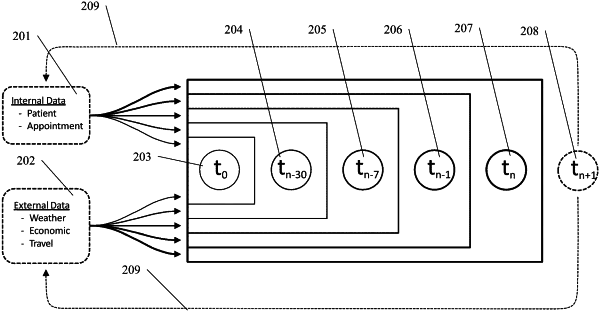| CPC G16H 40/20 (2018.01) [G06Q 10/1095 (2013.01); G16H 10/60 (2018.01); G16H 80/00 (2018.01)] | 26 Claims |

|
1. A computer-implemented method of increasing appointment attendance, comprising:
providing at least one processor; and at least one non-transitory memory including computer program code for one or more programs, the at least one non-transitory memory and the computer program code configured to, with the at least one processor, perform steps comprising:
obtaining an appointment data structure, comprising an attendee and a corresponding appointment for the attendee;
obtaining a set of electronic medical record (EMR) data related to the attendee, wherein the set of EMR data is in at least two different formats;
standardizing the at least two different formats of the set of EMR data;
at a first time:
obtaining a set of population data related to the attendee;
obtaining a set of appointment data related to the appointment;
obtaining a set of external data;
obtaining environmental data related to the region around a location of the appointment or the attendee at the first time;
inferring, using the standardized EMIR data, the population data, the appointment data, the external data, and the environmental data in a machine learning algorithm by the at least one processor and the at least one non-transitory memory, a probability that the attendee will attend the appointment; and
when the probability of attendance is below a threshold, performing a mitigation step selected from a first group of mitigation steps to increase the probability that the attendee will attend the appointment;
at a second time after the first time:
obtaining a second set of population data related to the attendee;
obtaining a second set of appointment data related to the appointment;
obtaining a second set of external data;
obtaining environmental data related to the region around a location of the appointment or the attendee at the second time;
inferring, using the standardized EMR data, the second set of population data, the second set of appointment data, the second set of external data, and the environmental data in the machine learning algorithm by the at least one processor and the at least one non-transitory memory, a probability that the attendee will attend the appointment; and
when the probability of attendance is below a threshold, performing a mitigation step selected from a second group of mitigation steps different from the first group of mitigation steps, to increase the second probability that the attendee will attend the appointment.
|